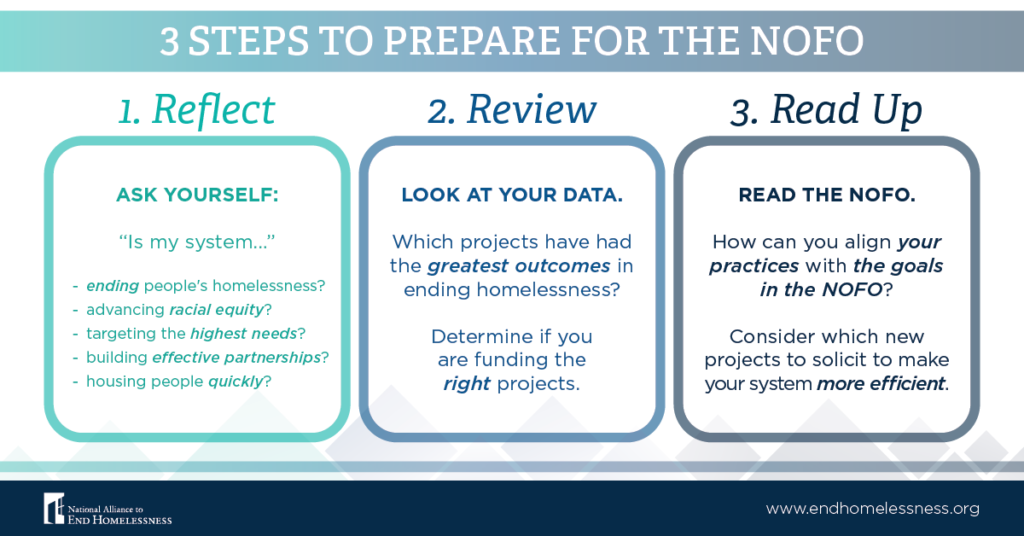Little did Cynthia know that those words would resonate more strongly than ever in 2021 as Continuums of Care (CoCs) have been overwhelmed for the past 17 months. CoCs have been forced to navigate the largest health crisis that has ever faced the homelessness system, while trying to manage the surge of resources on the ground to address the COVID-19 pandemic.
And now, one of the most daunting tasks for CoC applicants in “normal” years has hit the ground with the release of the U.S. Department of Housing and Urban Development (HUD) Notice of Funding Opportunity (NOFO) for the CoC Program Competition. This year, CoC leaders are already exhausted, and now must find the time (and energy) to complete a competitive NOFO application for critical funds to sustain their programs.
The first task for most homelessness systems is just reading the NOFO and figuring out what’s new, what HUD’s focuses are, and what gets scored. But I’m going to suggest that first you take a moment to reflect on the key focus areas for ending homelessness in your system, and what this means for your NOFO application.

Reflect
Given all the pressures facing homelessness systems at this moment, now is the time to regroup and get focused before you start this major task. I once read The Seven Habits of Highly Successful People. The one habit that has resonated throughout the years is “start with the end in mind”. The end goal for the NOFO to make your system more effective – so you should consider that first. What is ultimately your end goal? For homeless service providers, it should be to end homelessness in your community for as many people as possible – and to do it in an efficient, strategic, equitable way.
With that in mind, start by determining how will you use this NOFO as an opportunity to align your CoCs federal homelessness funding with other funding resources currently available to make your system more effective. This means that if a person becomes homeless in your community, it should be rare, brief, and one-time.
Key items to reflect on include:
- Is my system advancing racial justice and equity?
- Are we addressing those with the highest needs first, especially those living unsheltered?
- Are we growing partnerships that will accelerate our work?
- Are we focused on quickly getting people into housing?
- Are we acting quickly?
Then consider which projects you believe to be contributing to your system’s effectiveness, and which might need to be reallocated.
Review Data
Before you dig deeper into the NOFO, set aside time to review your system data and performance measures. Identify trends in meeting systemic outcomes. These should include: reducing length of time people spend homeless, increasing exits to permanent housing, reducing returns to homelessness, and reducing first time homelessness.
Which way are these metrics trending? Does it align with what you expected? And what funded projects are having the greatest impact on system outcomes? If there has been little progress, consider whether current projects are the best ones to fund.
Dive into the NOFO
Once you have taken time to reflect on key principles and review system data, use that lens to review the NOFO. Where do you see opportunities to align your practices with the goals outlined in the NOFO? Identify current projects that are meeting your performance targets. Determine areas where there are gaps, and then seek opportunities to strategically expand high-impact strategies by soliciting new projects that will meet your goals.
As you solicit new projects, be specific and succinct in what projects will further your system’s effectiveness. Utilize these same principles as you develop your rank and review tool to determine which projects will ultimately accompany your application. Review renewal projects carefully to determine if align with the five key items for reflection outlined at the top of this post. If not, it’s time to consider reallocation to interventions and projects that will better advance the goal of ending homelessness.
Remember, when you start with the end in mind, the process can feel like an opportunity to think smarter and be more strategic in your work. Knowing where you want to end makes getting started easier. We know where we want to be: ending homelessness for as many people as possible. The NOFO should be your guide on how to get there.

